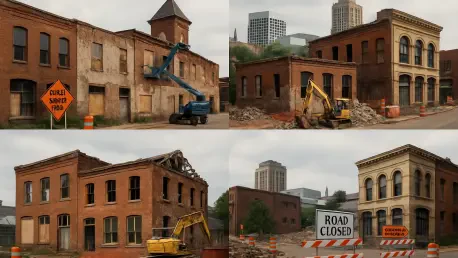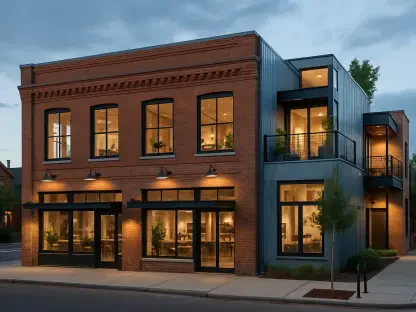In a significant setback for historic preservation efforts in Canton, Ohio, the Ohio Department of Development has rescinded substantial tax credits for two key redevelopment projects, casting a shadow over the revitalization of the city’s storied past. The Renkert Building, a towering structure from the early 20th century, and the Granger Building, both emblematic of Canton’s architectural heritage, have lost millions in financial support due to missed financing deadlines. This development not only highlights the economic challenges facing local developers but also raises broader questions about the feasibility of preserving historic properties in an era of tightened lending and rising costs. As economic conditions continue to fluctuate, the determination of developers to push forward despite these hurdles offers a glimpse into the resilience required to breathe new life into aging structures. This situation serves as a microcosm of the delicate balance between financial realities and the desire to maintain cultural landmarks.
Economic Challenges Impacting Redevelopment
Financial Hurdles and Revoked Credits
The Ohio Department of Development recently withdrew $9.77 million in historic tax credits for the Renkert Building and an additional $2 million for the Granger Building, citing the developers’ inability to secure necessary financing within the mandated 18-month timeframe. The Renkert Building, a 10-story edifice constructed in 1914 and vacant since 2017, was intended to transform into the Century Plaza Hotel under a prominent hotel brand. Meanwhile, the Granger Building was earmarked for conversion into apartments. High interest rates and stringent lending standards have created a challenging financial landscape, prompting delays in these ambitious projects. Developer Steve Coon, who leads the Renkert initiative alongside David Crisafi, openly acknowledged that unfavorable economic conditions forced a pause in progress. This revocation underscores a broader trend where economic constraints are stifling historic redevelopment efforts across regions, placing immense pressure on developers to navigate an unpredictable fiscal environment.
Broader Economic Trends Affecting Projects
Beyond the immediate loss of tax credits, the situation in Canton reflects a wider pattern of economic difficulties impacting historic preservation nationwide. Rising construction costs and limited access to favorable loans have compelled many developers to reassess or halt their plans, as seen with numerous stalled projects in recent times. The performance-based structure of Ohio’s historic tax credits, which provide up to 25% of qualified expenses only upon project completion, adds another layer of risk. If deadlines for financing are missed, as happened here, the financial support vanishes, leaving projects in limbo. For the Renkert and Granger Buildings, this has meant a significant setback, yet it also mirrors the struggles of other developers grappling with similar economic headwinds. The tightening of credit markets has not only delayed individual projects but also threatened the momentum of urban revitalization efforts, raising concerns about the long-term preservation of historical assets in communities like Canton.
Strategic Responses and Future Plans
Adapting Project Scope to Economic Realities
In response to the financial challenges and the loss of tax credits, the developers of the Renkert Building have made strategic adjustments to ensure the project’s viability. Originally, plans included a two-story addition featuring a parking garage and retail space, but escalating costs and low returns on such investments led to a pivot. Instead, the revised approach leverages nearby surface lots and the city’s Millennium Parking Deck for parking needs. Despite these changes, the vision for a hotel with an integrated restaurant remains intact, with the project still carrying an estimated cost of $48 million. This pragmatic shift demonstrates a keen awareness of balancing ambition with fiscal responsibility. Developer Steve Coon has emphasized the importance of adapting to economic pressures, illustrating how flexibility in planning can sustain progress even when significant funding is lost. This adaptation highlights a critical lesson for historic redevelopment: innovation in scope can be as vital as securing financial backing.
Optimism and Alternative Funding Strategies
Despite the setback, there is a palpable sense of optimism among the developers as they plan to reapply for the $9.77 million in tax credits for the Renkert Building, anticipating more favorable economic conditions in the near future. Coon has noted a growing consensus among industry peers that interest rates are beginning to stabilize and trend downward, potentially easing the financial strain on stalled projects. Beyond the hope for reinstated credits, other funding avenues remain secure, including $3.4 million from the Ohio Brownfield Remediation Program for asbestos removal and $4.2 million from the Transformational Mixed-Use Development Program. Additionally, a $9.62 million federal historic tax credit and private financing through loans, owner equity, and Property Assessed Clean Energy (PACE) financing bolster the project’s foundation. With a committed lender in place and readiness to start construction if credits are awarded later this year, the developers exhibit resilience. This multi-pronged funding strategy, paired with a proven track record in projects like the Historic Onesto Lofts, underscores a determined push forward.
Long-Term Vision and Prioritization
Looking ahead, the developers have outlined a phased approach to redevelopment in Canton, focusing first on stabilizing the Renkert Building before revisiting the Granger Building’s apartment conversion. A second phase envisions a six-story hotel affiliated with a major brand on adjacent property, signaling a long-term commitment to transforming the area into a vibrant hub. This staged strategy reflects a deliberate prioritization of resources, ensuring that each project receives the attention and funding necessary for success. Coon’s history of renovating historic properties, supported by experienced partners like Sandvick Architects, lends credibility to this vision. The focus on phased development also mitigates financial risks by spreading costs over time, a tactic that could serve as a model for other historic preservation efforts facing similar economic constraints. As plans unfold, the emphasis remains on creating sustainable, community-enhancing spaces while navigating the complexities of funding and market conditions.
Reflecting on Resilience in Historic Preservation
The journey of Canton’s historic redevelopment projects, marked by the revocation of crucial tax credits, reveals the intricate dance between economic challenges and the steadfast resolve to preserve cultural heritage. Developers faced formidable obstacles with high interest rates and stringent lending conditions derailing initial plans for the Renkert and Granger Buildings. Yet, their response—adapting project scopes, securing diverse funding, and maintaining a forward-looking mindset—demonstrates a remarkable capacity to adapt. As attention turns to reapplying for lost credits and leveraging stabilizing economic trends, the groundwork for future success is laid. Moving forward, stakeholders in historic preservation might consider fostering stronger public-private partnerships and advocating for more flexible tax credit timelines to buffer against economic volatility. These steps could ensure that the vision of revitalizing Canton’s historic landmarks, and others like them, endures as a testament to community spirit and perseverance.









